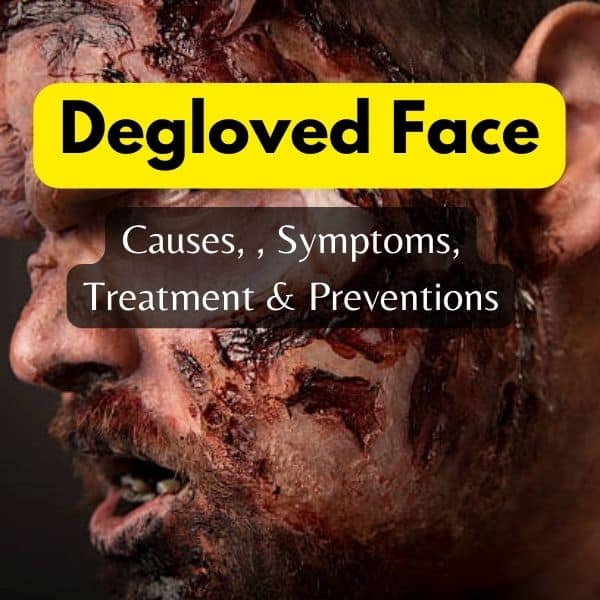Do you know what “degloved face” means?
A degloved face is a type of degloving injury in which the skin and soft tissues of the face are torn away from the underlying bones and muscles. This can cause significant damage, loss of function, and severe cosmetic defects.
A degloved face is a severe type of damage that can occur in car accidents, falls from great heights, or industrial mishaps. These injuries frequently necessitate immediate medical attention, including surgery, in order to repair the damage and restore function to the affected area.
It occurs when the skin and soft tissues are forcefully separated from the underlying tissue, leaving the affected areas stripped of their top layer of skin. These types of injuries can be extremely serious and potentially life-threatening, as they can result in significant blood loss and damage to the surrounding tissues.
In this section, we’ll look at the causes, symptoms, and treatment options for degloved face injuries. We’ll also go over how to avoid this type of injury and what to do if you or someone you know is involved in a degloving accident.
Pathophysiology of Injury
The layers of skin involved in a degloving injury are typically the top layer, known as the epidermis, and the layer beneath it, known as the dermis. The blood supply to these layers is critical for the survival of the tissues, as the blood vessels provide oxygen and nutrients that are necessary for healing.
Types of Degloved Injuries
Degloving injuries are classified into two types:
- Closed degloving injury occurs when the skin and soft tissue are pulled away from the underlying bone or muscle while the overlying skin remains intact. Closed degloving injuries are most common in locations where the skin is only loosely attached to the underlying tissue, such as the thigh, buttock, or back.
Closed degloving injuries, which occur when the skin is partially separated from the underlying tissue but remains intact, can also be a serious concern. These injuries can cause a condition known as a Morel-Lavallee lesion, which is a buildup of fluid between the skin and underlying tissues. If left untreated, this can lead to infection and other complications.
2. Open degloving injury: When the skin and soft tissue are entirely pulled away from the underlying bone or muscle, an open wound results. Injuries from open degloving are common where the skin is tightly attached to the underlying tissue, such as the hand, foot, or face.
The affected areas of a degloving injury can vary depending on the location of the trauma. For example, degloving injuries to the face can cause significant damage to the skin and soft tissue of the cheeks, nose, and forehead. Injuries to the arms or legs can affect larger areas of skin and soft tissue, potentially causing damage to muscles and bones as well.
Causes of a Degloved Face
A vehicle accident, particularly a car or motorbike crash, is one of the most prevalent causes of a degloved face, especially if the rider is not wearing a helmet if the impact is aimed towards the face. This type of injury can also be caused by workplace accidents, sports injuries, animal attacks, physical assaults, and natural calamities.
Signs and Symptoms of Degloved Face
Severe pain, swelling, and bleeding at the site of injury, loss of skin color, texture, and sensation in the affected area, exposure of bones, muscles, or organs that should be covered by skin, impaired vision, hearing, or breathing if the face is affected, difficulty speaking, eating, or drinking due to the facial nerve or muscle damage, and infection risk, if the wound is not treated promptly and properly, are all symptoms of a degloved face.
Diagnosis
If you feel that someone you know has a degloving injury, get emergency medical assistance right once. To determine the extent and location of the damage, a doctor or trauma team will perform a comprehensive physical exam, review the medical history and circumstances of the incident, and request diagnostic procedures such as X-rays, CT scans, or MRI scans.
Treatment of a Degloved Face
Treatment for degloving injuries typically involves a surgical intervention to repair the damaged tissues. Depending on the severity of the injury, skin flaps or skin grafts may be necessary to restore the affected areas. Skin flaps involve taking healthy tissue from one area of the body and relocating it to the damaged area to provide coverage and promote healing. Skin grafts, on the other hand, involve taking a section of skin from one area of the body and transplanting it to the damaged area.
Prevention of Degloving Injuries
When it comes to degloved face injuries, prevention is everything. Wearing appropriate personal protective equipment (PPE) such as helmets, face shields, goggles, gloves, or boots when working, playing, or riding, adhering to safety guidelines and procedures at your workplace, school, or recreational facility, avoiding risky behaviors such as driving under the influence, speeding, or texting while driving, teaching children about the importance of safety and supervision around animals, playgrounds, or pools, and seeking prompt medical attention for any injuries, especially if they involve the face or head.
Conclusion
To summarise, degloved face injuries are serious and potentially fatal, but they can be avoided by taking the necessary precautions and according to safety recommendations. If you or someone you know suffers a degloving injury, get emergency medical assistance right once to maximize recovery and reduce the risk of complications. Keep yourself and your loved ones safe and healthy!
Read More about Degloved Face – Click Here
You May Also Like
- Understanding Leptospirosis: A Comprehensive Guide to Animal Health in 2024
- Ultimate Guide to Life Expectancy of PNH Disease and Key Factors: Mastering PNH Understanding
- Understanding Hunter Syndrome: A Comprehensive Guide to a Rare Genetic Disorder in 2024
- Pentasomy X Syndrome: A Comprehensive Guide for Patients and Researchers in 2024
- Tips for Getting Better Sleep with Anxiety in 2024
